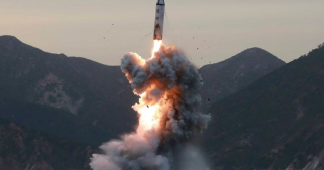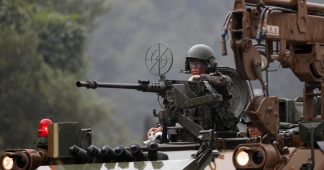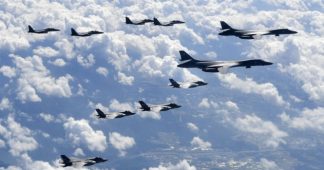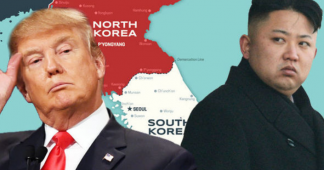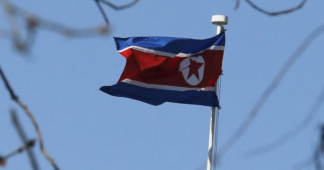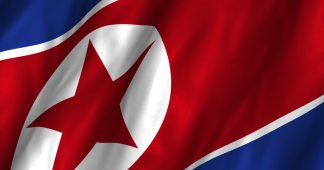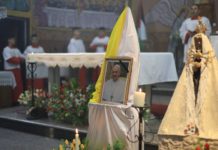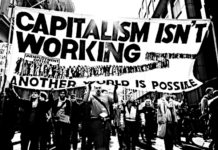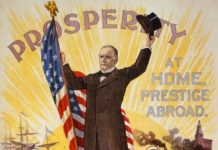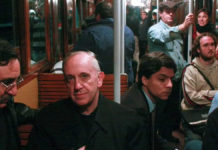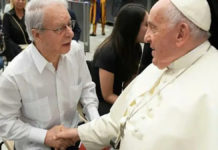By Charles Armstrong
March 16, 2009
This article is part of an ongoing series at The Asia-Pacific Journal commemorating the sixtieth anniversary of the start of the US-Korean War.
The American Air War and the Destruction of North Korea
The Korean War, a “limited war” for the US and UN forces, was for Koreans a total war. The human and material resources of North and South Korea were used to their utmost. The physical destruction and loss of life on both sides was almost beyond comprehension, but the North suffered the greater damage, due to American saturation bombing and the scorched-earth policy of the retreating UN forces.1 The US Air Force estimated that North Korea’s destruction was proportionately greater than that of Japan in the Second World War, where the US had turned 64 major cities to rubble and used the atomic bomb to destroy two others. American planes dropped 635,000 tons of bombs on Korea — that is, essentially on North Korea –including 32,557 tons of napalm, compared to 503,000 tons of bombs dropped in the entire Pacific theatre of World War II.2 The number of Korean dead, injured or missing by war’s end approached three million, ten percent of the overall population. The majority of those killed were in the North, which had half of the population of the South; although the DPRK does not have official figures, possibly twelve to fifteen percent of the population was killed in the war, a figure close to or surpassing the proportion of Soviet citizens killed in World War II.3
The act which inflicted the greatest loss of civilian life in the Korean War by far, one which the North Koreans have claimed ever since was America’s greatest war crime, was the aerial bombardment of North Korean population centers. American control of the skies over Korea was overwhelming. Soviet MIGs, flown by Soviet, Chinese, and North Korean pilots, were sometimes effective against American air power. But under Stalin’s orders, the Soviet fighter planes were strictly limited in number and in the range they were allowed to fly, lest US-Soviet air battles lead to a larger war.4 And in any case, Soviet air support did not come until the end of 1950. During the summer and fall, North Korean air defenses were virtually non-existent. Lightly armed, local self-defense units in occupied South Korea could only watch and suffer as their towns and villages were obliterated from the air.5 By the end of the war, North Korea claimed that only two modern buildings remained standing in Pyongyang.
For the Americans, strategic bombing made perfect sense, giving advantage to American technological prowess against the enemy’s numerical superiority. The American command dismissed British concerns that mass bombardment would turn world opinion against them, insisting that air attacks were accurate and civilian casualties limited.6 Russian accusations of indiscriminate attacks on civilian targets did not register with the Americans at all. But for the North Koreans, living in fear of B-29 attacks for nearly three years, including the possibility of atomic bombs, the American air war left a deep and lasting impression. The DPRK government never forgot the lesson of North Korea’s vulnerability to American air attack, and for half a century after the Armistice continued to strengthen anti-aircraft defenses, build underground installations, and eventually develop nuclear weapons to ensure that North Korea would not find itself in such a position again. The long-term psychological effect of the war on the whole of North Korean society cannot be overestimated. The war against the United States, more than any other single factor, gave North Koreans a collective sense of anxiety and fear of outside threats that would continue long after the war’s end.
North Korea’s considerable economic achievements since liberation were all but completely wiped out by the war. By 1949, after two years of a planned economy, North Korea had recovery from the post-liberation chaos, and economic output had reached the level of the colonial period.7 Plans for 1950 were to increase output again by a third in the North, and the DPRK leadership had expected further economic gains following integration with the agriculturally more productive South after unification. According to DPRK figures, the war destroyed some 8,700 factories, 5,000 schools, 1,000 hospitals and 600,000 homes.8 Most of the destruction occurred in 1950 and 1951. To escape the bombing, entire factories were moved underground, along with schools, hospitals, government offices, and much of the population. Agriculture was devastated, and famine loomed. Peasants hid underground during the day and came out to farm at night. Destruction of livestock, shortages of seed, farm tools, and fertilizer, and loss of manpower reduced agricultural production to the level of bare subsistence at best. The Nodong Sinmun newspaper referred to 1951 as “the year of unbearable trials,” a phrase revived in the famine years of the 1990s.9 Worse was yet to come. By the fall of 1952, there were no effective targets left for US planes to hit. Every significant town, city and industrial area in North Korea had already been bombed. In the spring of 1953, the Air Force targeted irrigation dams on the Yalu River, both to destroy the North Korean rice crop and to pressure the Chinese, who would have to supply more food aid to the North. Five reservoirs were hit, flooding thousands of acres of farmland, inundating whole towns and laying waste to the essential food source for millions of North Koreans.10 Only emergency assistance from China, the USSR, and other socialist countries prevented widespread famine.
North Korean Reconstruction as a “Fraternal Socialist Project”
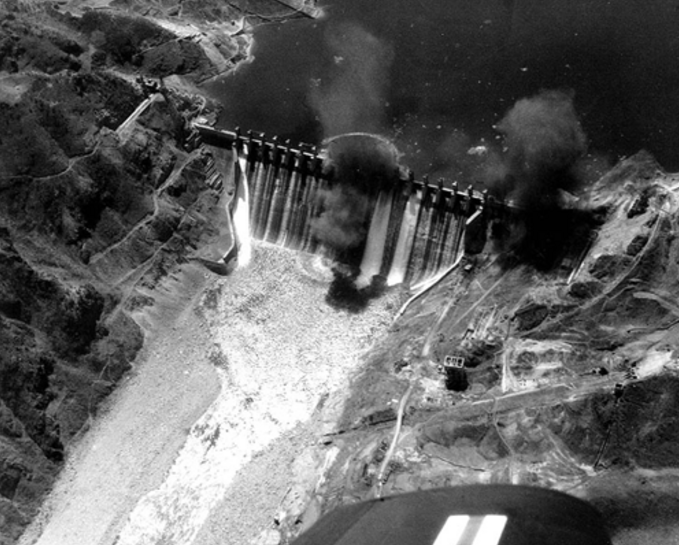
When the fighting stopped in the summer of 1953, the entire Korean peninsula lay in utter ruin. South of the DMZ, the United States and its allies led an ambitious, and well-funded, effort to rehabilitate South Korea under the auspices of the United Nations Korea Reconstruction Agency (UNKRA).11 North Korea, even more devastated than the South and suffering as well from a labor shortage caused by the population hemorrhage of the war, had far fewer resources with which to rebuild itself. Yet through a combination of tremendous work and sacrifice on the part of the North Korean people, generous economic and technical assistance from the “fraternal” socialist countries, and the advantage of a pre-war industrial infrastructure more developed than that of South Korea, the DPRK soon achieved economic growth rates that far surpassed South Korea’s into the 1970s. In the late 1950s North Korea’s growth rate of total industrial output (averaging 39% between 1953 and 1960) was probably the highest in the world.12
North Korea had been virtually destroyed as an industrial society, and the first priority of the DPRK leadership was to re-build industry. Within days of the armistice, Kim Il Sung sent a report to the Soviet embassy in Pyongyang, detailing the extent of war damage and the need for Soviet assistance to rehabilitate North Korea’s industrial economy. “Fraternal” aid to the DPRK began during the Korean War. Of course the great bulk of direct military assistance came from the USSR and China, but the East European “People’s Democracies” also contributed to the war effort with logistical support, technical aid, medical supplies and the like. Among the most poignant forms of assistance was the taking in of thousands of Korean war orphans. Romania alone reportedly sheltered some 1,500 of these children, who were returned to the DPRK with the completion of North Korea’s 1957 – 1961 Five-Year Plan. The first group of 205 Korean children were sent to the GDR in January 1953. These and hundreds of others were also returned to North Korea several years later.
Kim Il Sung led a delegation to Moscow in September 1953, primarily to settle the terms of Soviet assistance. The Soviet government agreed to cancel or postpone repayment for all of North Korea’s outstanding debts, and reiterated its promise to give the DPRK one billion rubles in outright aid, both monetary and in the form of industrial equipment and consumer goods. Soviet technicians were sent to North Korea to help with the rehabilitation effort. The bulk of factory reconstruction in post-war North Korea was supervised by Soviet experts. Pyongyang also received promises of aid from East European countries and the Mongolian People’s Republic, the latter promising to send North Korea some 86,500 head of livestock. The third-largest contributor of external assistance after the Soviet Union and China was East Germany, which played a major role in the rebuilding of Hamhŭng, North Korea’s second-largest city and an important industrial center,.
Kim visited Beijing in November and received similarly generous pledges from the PRC, reflecting in part the Chinese government’s interest in competing with the USSR for influence in North Korea. China cancelled North Korea’s debts from the Korean War, and offered the DPRK 800 million yuan in aid for the period 1954 – 1957, of which 300 million would come in the first year. North Korea and China also signed an agreement on economic and cultural cooperation similar to the one signed between the DPRK and USSR in March 1949. China helped North Korea in factory reconstruction, although not on the scale that the USSR did, and became a major source for North Korean consumer goods, including textiles, cotton, and foodstuffs. Chinese technical experts went to North Korea, and Koreans traveled to China for technical training. But perhaps the most important contribution that China made to North Korea’s reconstruction, in addition to monetary aid and debt cancellation, was the manpower supplied by Chinese People’s Volunteer (CPV) troops who remained in North Korea until 1958. These troops, who numbered in the thousands, helped repair roads and rail lines damaged by war and rebuild schools, bridges, tunnels and irrigation dams. In labor-short North Korea, the physical assistance of Chinese People’s Volunteers was invaluable for the rehabilitation of the war-damaged infrastructure.
The period of post-war reconstruction in North Korea was the first and only time the Soviet Union, China, and the Soviet-aligned countries of Eastern Europe and Mongolia cooperated on a large-scale economic project of this nature. It was the historical high point of “international socialist solidarity,” one that would never be repeated after the USSR and China fell out in the early 1960s. Considering that the Soviet Union was still rebuilding from the devastation of World War II, that China had only recently concluded its civil war, and that East Germany (the third-largest aid source) was rebuilding from war as well, the scale of aid to North Korea is remarkable. Contemporary Soviet sources give a breakdown in foreign assistance to the DPRK between 1953 and 1960 as dividing roughly into thirds, no doubt a division of labor suggested by Moscow. Exactly one-third (33.3%) of reconstruction aid came from the USSR, 29.4% from China, and 37.3% from other countries. The monetary figures do not take into account aid in labor, which was particularly important on the Chinese side.
Source: SSSR i Koreia (Moscow: USSR Academy of Sciences, 1988), p. 256
North Korea was dependent on fraternal assistance for more than 80% of its industrial reconstruction needs between 1954 and 1956, the period of the Three-Year Plan.
North Korea could not possibly have rebuilt its economy as quickly as it did without this massive inflow of aid into nearly every sector of production and consumption. But the DPRK did not remain aid-dependent for long. Partly this was out of necessity, as socialist-bloc aid was intended from the beginning to be phased out as reconstruction was completed. Yet it is remarkable how quickly North Korea’s aid dependency dropped – North Korea’s declaration of “self-reliance” by the end of the 1950s was not without substance. In 1954, 33.4% of North Korea’s state revenue came from foreign aid; in 1960, the proportion was down to a paltry 2.6%. By contrast, well over half of South Korea’s government revenue came from foreign assistance in 1956. By the early 1960’s, well before South Korea’s industrial take-off, the North had impressively re-industrialized. This difference cannot be explained by foreign aid alone, which was far greater in absolute terms in South Korea than in the North. The regime’s ability to mobilize the North Korean population was also indispensable for the success of this project. As Kim Il Sung had said, economic reconstruction would require all the work and resources the North Korean people could muster.
Urban Reconstruction in Pyongyang and Hamhŭng
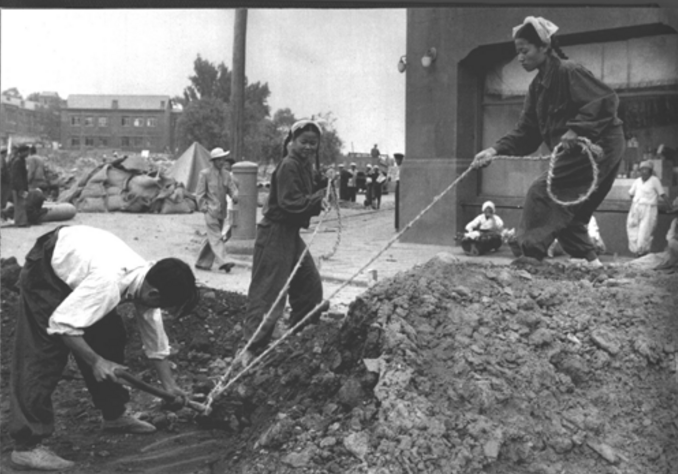
In the reconstruction of Pyongyang, as in the North Korean economy more generally, fraternal assistance was massive, diverse, and crucial. At the time, this help was warmly and extensively acknowledged in the DPRK media. After the 1960s, when self-reliance became both the dominant slogan and the lens through which all previous North Korean experiences were filtered, the role of foreigners in post-war reconstruction was rarely if ever mentioned. Broadly speaking, China contributed mainly manpower and light consumer goods, the Soviets and East Germans supplied technical assistance and supervision, and the other East European countries gave equipment and technical assistance for specific industries. Kim Il Sung publicly thanked the Chinese People’s Volunteers, who had fought “shoulder-to-shoulder” with the Korean People’s Army, for their continued role in the post-war reconstruction effort. CPV soldiers helped rebuild bridges, elementary schools, factories and apartments. In February 1955, for instance, the 47th Brigade of the CPV rebuilt the Pyongyang Electric Train Factory. A group of more than 770 Chinese construction experts stayed in Pyongyang from November 1954 to the end of 1956 to help oversee reconstruction. Albania donated asphalt for paving roads, Czechoslovakia gave buses, Hungary built a precision tool factory, East Germany gave telephones and switchboards for the city’s communication services and modernized the National Film Production Center. Poland built the West Pyongyang Railway Factory, Bulgaria built a factory for wooden tools, Romania built up Pyongyang Central Hospital, and the USSR, Czechoslovakia, China and East Germany each contributed engines and freight and passenger cars to develop the North Korean railroad industry. During the period of the Three-Year plan, many East European leaders visited Pyongyang, where they were warmly thanked for their countries’ contributions to post-war reconstruction, including Otto Grotewohl of the GDR, Enver Hoxha of Albania, and Gheorghiu-Dej of Romania.
In the face of the Chinese advance in late November and December 1950, the US Army X Corps withdrew toward the Hamhŭng/Hŭngnam area to be evacuated by sea. Hamhŭng had already been bombed by the US Air Force, but the X Corps had been ordered to “deny the Communist troops supplies and transportation facilities” before they left the area. For several days, beginning December 11, the 185th Engineering Battalion of X Corps hauled some four tons of dynamite to the industrial outskirts of Hŭngnam and began to destroy what remained of the factories. On December 15, the railroad bridge leading south from Hamhŭng was blown up. All the highway bridges in the vicinity were similarly demolished. Three days later, the First Platoon burned all the buildings and destroyed all aviation supplies at Hamhŭng’s Yongp’o airport, about five miles south of Hŭngnam, with gasoline, tracer bullets and grenades; for good measure, a naval bombardment hit the airport later that afternoon. Meanwhile, some 100,000 North Korean refugees were transported from Hŭngnam to South Korea by US navy LST’s in the so-called “Christmas Evacuation” of December 19 – 24. Out of the rubble of a destroyed and depopulated Hamhŭng, the North Koreans and East Germans built a new industrial city.
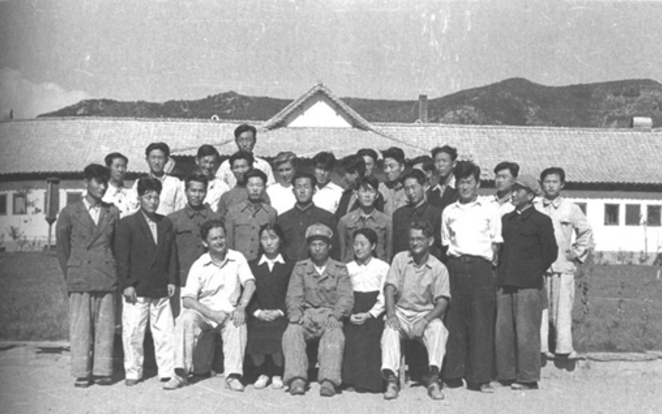
It is not clear exactly when, and by whom, the decision was made for East German aid to focus on the city of Hamhŭng. It appears that GDR Prime Minister Otto Grotewohl personally promised Kim Il Sung help in rebuilding a city when the two men met at the Geneva Conference in 1954. Later that year, in late June or early July, a North Korean leader (presumably Kim Il Sung) wrote to Grotewohl:
The government and the whole Korean people are endlessly touched and thankful for the promise given by you, dear comrade Prime Minister, to our delegation at the Geneva Conference, to rebuild one of the destroyed towns by the efforts of the German Democratic Republic…The government of our Republic has decided as the object of reconstruction and recovery by your government the city of Hamhŭng, one of the provincial centers of our Republic.13
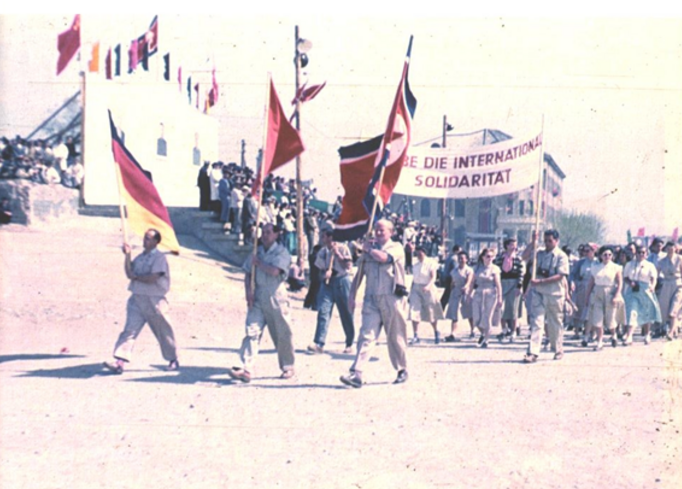
Perhaps Grotewohl, presiding over a war-damaged country himself, was moved by a sense of common bond with the Koreans; perhaps he was pressured by the Soviets to give East German aid to a major industrial reconstruction project, but not in the capital, which would be a showcase of Soviet aid. In any case, Grotewohl himself headed a “German Work Team” (Deutsche Arbeitsgruppe, DAG) to direct the project. Hundreds of East German engineers, technicians, craftsmen and their families were sent to Hamhŭng, some residing for several years, and gained the collective, ironically German-sounding nickname “Hamhunger.” In the fall of 1954 a GDR delegation visited Hamhŭng to lay the groundwork for the reconstruction project, and the following year the East German government announced its plan to help in the reconstruction of Hamhŭng for the period 1955 – 1964
In just over five years, North Koreans with East German assistance rebuilt Hamhung as a modern industrial city, and for decades the city would be the main industrial hub of North Korea outside the capital Pyongyang. In 1960 – long before the term would be applied to South Korea – the East German press called North Korea “an economic miracle in the Far East.”14 In June 1956, Kim Il Sung visited the GDR and personally thanked the East Germans for their help.15 But from the beginning of the reconstruction process, the DPRK leadership had seen foreign assistance as a limited process that would gradually give way to North Korean self-reliance.16 In December 1955 Kim made his subsequently famous speech about “Juche” or self –reliance, Originally referring to ideological independence, especially with regard to the Soviet Union, over the course of the next two decades Juche would be extended to all aspects of North Korean behavior, from politics to economics to military defense.
The DPRK and GDR governments declared the Hamhŭng project completed in1962, two years ahead of schedule. The German specialists and their families went home. At the same time, the thousands of Korean orphans taken in by German, Romanian, and other East European families, were sent back to Korea. Some North Korean students remained in Eastern Europe and the USSR, but the era of close “fraternal cooperation” had come to an end. North Korea had been rebuilt, and from this point onward would chart its own distinct course of political and economic development, connected but never subordinated to the broader socialist community of nations.
* Charles Armstrong is professor of history and Director of the Center for Korean Research at Columbia University. He is the author of The North Korean Revolution, 1945 – 1950 and The Koreas, and editor of Korean Society: Civil Society, Democracy and the State and Korea at the Center: Dynamics of Regionalism in Northeast Asia.
Recommended citation: Charles Armstrong, The Destruction and Reconstruction of North Korea, 1950 – 1960, The Asia-Pacific Journal Vol 8, Issue 51 No 2, December 20, 2010.
Other articles on the sixtieth anniversary of the outbreak of the US-Korean War are:
Steven Lee, The United States, the United Nations, and the Second Occupation of Korea, 1950-1951.
Heonik Kwon, Korean War Traumas.
Han Kyung-koo, Legacies of War: The Korean War – 60 Years On.
Additional articles on the US-Korean War include:
Mel Gurtov, From Korea to Vietnam: The Origins and Mindset of Postwar U.S. Interventionism.
Kim Dong-choon, The Truth and Reconciliation Commission of Korea: Uncovering the Hidden Korean War
Tessa Morris-Suzuki, Remembering the Unfinished Conflict: Museums and the Contested Memory of the Korean War.
Notes
1 Far East Command ordered General Walker to “destroy everything that might be of use to the enemy” as the Eighth Army fled South in December 1950. Roy E. Appleman, Disaster in Korea: The Chinese Confront MacArthur (College Station, TX: Texas A & M Pres, 1989), p. 360.
2 Cited in Rosemary Foot, A Substitute for Victory: The Politics of Peacemaking at the Korean Armistice Talks (Ithaca: Cornell University Press, 1990), pp. 207 – 208.
3 Jon Halliday, “The North Korean Enigma,” New Left Review no. 127 (May – June 1981), p. 29.
4 The extent of Soviet air involvement in the Korean War was long a secret of the Cold War, whose details only become known after the collapse of the USSR. See Xiaoming Zhang, Red Wings over the Yalu: China, the Soviet Union, and the Air War in Korea (College Station: Texas A&M University Press, 2002).
5 US National Archives, Record Group 242, shipping advice 2013, item 1/191. Organization of Armed Home Defense Units (DPRK), September 1950. Reports include graphic descriptions of an air attack on the city of Yŏch’ŏn on August 26, and the bombing of an elementary school on September 1.
6 Conrad C. Crane, American Airpower Strategy in Korea, 1950 – 1953 (Lawrence: University Press of Kansas, 2000), pp. 42 –43.
7 US National Archives, Record Group 59. U.S. Embassy to State, “Economic Conditions in North Korea,” October 11, 1949, p. 8.
8 “The Three Year Plan,” Kyŏngje kŏnsŏl [Economic Construction], September 1956, pp. 5 –6.
9 Nodong Sinmun, March 16, 1952, p. 1.
10 Callum MacDonald, Korea: The War Before Vietnam (London: Macmillan, 1986), pp. 241 – 242.
11 The post-war reconstruction of South Korea was the world’s largest multilateral development project at the time. See Stephen Hugh Lee, “The United Nations Korea Reconstruction Agency in War and Peace,” in Chae-Jin Lee and Young-ick Lew, eds., Korea and the Korean War (Seoul: Yonsei University Press, 2002), pp. 357 – 96.
12 John Yoon Tai Kuark, “A Comparative Study of Economic Development in North and South Korea during the Post-Korean War Period,” Ph.D. dissertation, University of Minnesota, 1966, p. 32; Joseph S. Chung, The North Korean Economy: Structure and Development (Stanford: Hoover Institution Press, 1974), pp. 146-47.
13 Cited in Ruediger Frank, Die DDR und Nordkorea: Dier Wiederaufbau der Stadt Hamhung von 1954 – 1962 (Aachen: Shaker, 1996), p. 23.
14 Martin Radmann, “Ein Wirtschafstwunder im Fernen Osten,” Neues Deutschland, December 27, 1960.
15 GDR Foreign Ministry, Korea section. “Visit of a Government Delegation of the DPRK in the GDR, June 1956.” MfAA A 6927, Fiche 1.
16 Kim Il Sung, “On Eliminating Dogmatism and Formalism and Establishing Juche in Ideological Work,” Works vol. 9, pp. 395 – 417.
